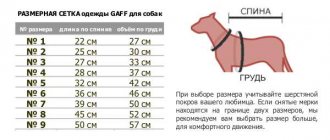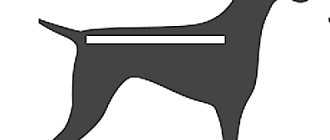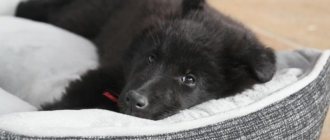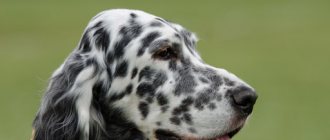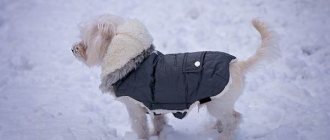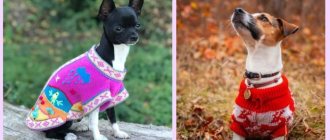Do you want your pet to look as stylish as you, but don't know how to measure your dog for clothes? Or do you live in a place with cold winters and want your four-legged friend to feel warm and cozy? Measuring the size of a dog is a simple but responsible process. The correct size of clothing directly depends on whether your pet will feel discomfort and, accordingly, whether this will not cause problems with his health.
Long-haired pets practically do not need insulated clothing, no matter how beautiful they look. Overheating can disrupt their temperature balance and lead to dire consequences.
What shoe size does a spaniel have?
Dog Shoe Size Chart
| Size | Sole length, cm | Breed of dog |
| 2 | 4.5 | Yorkshire Terrier, Toy Terrier, Maltese, Japanese Chin, Pomeranian Spitz |
| 3 | 5 | Chinese Crested, Pug, Toy Poodle, Large Yorkie, Shih Tzu, Miniature Pinscher |
| 4 | 5,5 | Miniature poodle, shih tzu, fox |
| 5 | 6 | Cocker spaniel , poodle |
Basic rules for measuring
Before choosing clothes for your dog, you need to prepare:
- To prevent your pet from being distracted and nervous when taking measurements, he is “introduced” to the measuring objects in advance.
- It is better to carry out the measurement process with three people: the owner holds the pet, another person measures, and a third writes down the result.
- The first measurement of the dog is carried out in a show position with a straight back. The second time, the animal is measured in a free, relaxed body position.
- Only the widest places are measured.
- If the data obtained is between two sizes, then choose the one that is larger.
- The back is the main parameter when measuring. In a controversial situation, you need to navigate only by it.
- When measuring your pet's chest, add another 2-4 cm to the results obtained. Otherwise, the clothing will greatly compress the chest when moving.
- For greater accuracy, three approaches are taken to take measurements from the dog for the overalls. As a result, the average value is calculated, which is considered the most reliable.
How to choose the right costume for your pet?
The very first rule when buying clothes for a dog is to take your pet with you to the store to try it on. Be prepared right away that the fitting process will take some time, and you will have to try on at least five models to understand which one your “fashionist” or “fashionista” will feel most comfortable in. It is very important that the clothes fit loosely, do not restrict the dog’s movements, do not put pressure on the paws, neck, but at the same time do not “dangle”.
Clothing must match the pet's breed, taking into account its breed characteristics. There are separate sizes for dachshunds, corgis, bulldogs and pugs; you should not try to squeeze them into overalls for other breeds: they will be uncomfortable in the neck for bulldogs, and the length will not suit dachshunds. For hairless breeds, you should choose clothes with neat seams. Rough seams and textured fabric can cause discomfort for naked people.
The overalls should not be too big, otherwise there is a risk that when going for a walk, urine and feces will get inside the clothes.
Clothes for your pet should be easy to put on and take off. Preference should be given to zippers in the fastener, because Velcro fasteners very quickly become clogged with wool and no longer securely fix the suit.
The presence of a reflective strip on the overalls will allow you to control your pet’s movement in the dark and make it more visible to vehicle drivers. Knitted clothes are beautiful, but not so practical to care for and are not suitable for wearing when walking in wet weather.
When buying clothes, it is not enough to just try them on on a standing dog; you need to see how the pet moves in the new clothes - let him walk around the store for a few minutes.
You can ask the dog to sit, lie down, give a paw and, if possible, move up the stairs. While the dog is moving in new clothes, it is advisable to check with your hands whether the clothes are pulling in the armpits. If the dog behaves in clothes the same way as usual, it is comfortable, then the clothes were chosen well. A small exception to this advice would be dogs trying on clothes for the first time: out of habit, their movements will be noticeably constrained, but within 10–15 minutes the dog begins to behave more freely in a new image.
Features of ideal shoes
The height of the boot - the boot allows you to firmly fix the paw, its height depends on the size and build of the pet - the taller and larger the dog, the higher the boot should be.
Sole – it is advisable that the boots have a polyurethane sole with tread and a slight bend. Thus, the paws will be reliably protected and excellent grip on any surface is guaranteed.
Fastener – shoes can be lace-up, strap or zipper. There must be at least two straps so that the boot does not slip off. It is not recommended to take shoes with zippers for long-haired breeds - hair may get caught in the lock.
Weight. The weight of the shoes should correspond to the size and build of the dog. The dog should feel comfortable and relaxed, run freely and not be distracted by “things” on its paws.
Decorations. Indeed, the brighter and more original the shoes, the more unique and attractive the dog becomes. But you should know that the fewer accessories, the lighter and more comfortable the boots.
Warmth - pet stores offer a large selection of fur-lined boots. In fact, there is no need to buy a “winter” version, since only the paws have sweat glands. In warm shoes, your feet will swell and sweat.
If your pet is cold, it is better to purchase a suit or blanket.
Note!
Shoes must be:
- thin at the bend of the paw so that the dog does not feel like a person in ski boots;
- without internal seams, as they can rub the paws;
- with a thick toe, otherwise your pet’s claws will turn your shoes into a sieve after the first walk.
Why do you need to know the height of the dog at the withers?
Height at the withers is an important parameter for dogs. It is one of the three main standards in conformation, along with oblique body length and pastern girth. In addition, its location and the pet’s growth must be known for:
- determining the required jump height in sports competitions;
- comparison of the pet’s parameters with accepted breed conformation standards;
- identifying abnormalities in the development of puppies;
- selecting the correct size of harness, carrier and clothing.
It is also necessary to know where the dog’s withers are during veterinary procedures: injections, vaccinations, antiparasitic treatment.
The subcutaneous fatty tissue located here contains many blood vessels, which ensures good absorption of drugs. This place is also characterized by reduced sensitivity. Therefore, the procedures are performed as painlessly and with the least discomfort as possible.
The abundance of blood vessels also enhances the effect of medications against fleas, ticks, and worms. The temperature in this place is slightly higher than in other parts of the body. And the pet cannot reach the medicine with its tongue or teeth.
How to detect the withers
Even owners who have had more than 2 or 3 dogs sometimes have no idea what the withers are and where they are located on the pet. In addition to the fact that the withers are a reference point and a starting point when measuring a dog’s height, knowledge of its location is useful in other cases.
Some time after the birth of a purebred individual, all puppies undergo mandatory vaccination, as well as treatment with insecticidal agents. This helps protect the young growing body from parasites, infections and serious diseases. The fact is that all such vaccinations are carried out precisely in the area near the withers. The withers are considered the most suitable place for vaccinations - in this area the skin is the least sensitive, and there is also a kind of skin pocket in which the entire dose of the drug is placed.
The same applies to the usual treatment of pets' fur and skin against parasites using special drops - the skin on the withers will ensure a gradual supply of the drug into the blood.
When choosing a collar and other accessories for your dog, it is the girth of the withers that is decisive in determining the appropriate accessory.
When puppies are born, bitches take them by the withers to carry them to another place (in everyday language this place is called the “scruff”). This place is the least painful for dogs, so even owners are advised to carry puppies exclusively in this way. It is believed that when carried by the withers, puppies feel as safe as possible.
The next task that will confront you is to discover this very withers.
For experienced owners, this procedure will take only a few seconds; for those who are encountering dogs for the first time, it should not take even a minute.
Instructions for detecting withers will be located below:
- Place your hands, palms down, on your pet's shoulders and press them firmly against your pet's body;
- With slow but gradual movements, move your hands (without breaking away or releasing pressure) along the animal’s skin until one or more folds form in front;
- move your hands forward all the way to the shoulder blades;
- the fold that is formed through such manipulations of the skin is the nape, and this, in turn, is the skin surface directly above the withers.
Also, to find the withers, you can use any flat and heavy enough object (to put pressure on the coat). Most often, a small book plays this role.
Place it where you think there is a transition from the neck to the body. If the book takes a position parallel to the floor, the withers have been found.
When is it recommended to wear clothes?
People have bred many ornamental animals, for some of them the scorching sun and cold are destructive. For example, a miniature pinscher must wear clothes both in summer and winter. The Labrador, which has a thick coat, requires regular grooming and therefore needs comfortable clothing. Small dogs have a much higher heat transfer rate than large breeds. Because of this, your pet can easily catch a cold in a draft or get sick if it gets cold. Short-haired dogs do not have an undercoat, and clothing is the only way for them to protect themselves from adverse weather conditions.
Owners of four-legged animals often resort to grooming services.
During grooming procedures, pets are given short haircuts. Because of this, a sharp disturbance in heat metabolism occurs in the animal’s body and the likelihood of illness increases. Note! Professionals warn that your pet needs to wear clothes for some time after visiting the grooming salon.
The body of animals undergoes numerous changes with age. Older dogs have problems with thermoregulation, they often get cold and experience problems with arthritis. Such animals should be protected. It is very important for owners of older dogs to take care of their pet and create a suitable wardrobe for it.
A nursing mother should absolutely not freeze. Her mammary glands should be warm. Otherwise, mastitis may occur.
Clothing for dogs not only protects their health, but also protects them in bad weather. A raincoat allows your dog to stay dry and clean. Even if it is raining outside, the breeder will not have to bathe the animal completely; it will be enough to wash the paws. In addition, in winter, roads are sprinkled with reagents that can provoke an allergic reaction. In this case, boots will protect the dog’s limbs from harmful effects.
On a note! Not all animals are suited to living in a booth. Today's popular floor coverings (tiles, parquet boards, linoleum and laminate) are dangerous and inconvenient for pets. Socks with stoppers for babies and adults will be truly comfortable.
Special dog panties designed for the period of estrus not only prevent mating, but also protect the house from secretions appropriate for this period.
Pet clothing also brings a lot of positive emotions to breeders. Dogs walking in dresses and suits evoke delight and tenderness not only among their owners, but also those around them.
This is interesting! Some caring owners sew costumes for adult pets and puppies with their own hands.
High-quality clothing will keep your pet from freezing
Clothing size charts
The manufacturer of each type of clothing indicates its own parameters. Average indicative data is shown in tables designed for pets of large, medium or small breeds. There is a separate table for dogs with a non-standard body shape.
Table for determining clothing sizes for pugs, as well as pets of large and medium breeds:
| Designation | Dimensions, mm | Breed (approximately!) | |
| Back length | Bust | ||
| A0 | 350 | 550 | Scottish Terrier, West Highland White Terrier |
| A1 | 300 | 500 | French bulldogs, pugs |
| A2 | 350 | 550 | American and English Cocker Spaniels, Beagles, Fox Terriers, Miniature Schnauzers, Shelties, Medium Spitz, Chinese Crested |
| A3 | 400 | 600 | |
| B1 | 400 | 700 | Bull Terriers, Staffordshire, Wheaten, Kerry Blue Terriers, Collies, Shar-Peis |
| B2 | 450 | 750 | |
| B3 | 500 | 800 | |
| C1 | 550 | 750 | Labradors, Huskies, Dobermans, Golden Retrievers, Boxers, Akitas |
| C2 | 600 | 800 | |
| C3 | 650 | 850 | |
| D1 | 700 | 950 | Rottweilers, Great Danes, Boxers, St. Bernards, |
| D2 | 750 | 1000 | Dobermans, Cane Corsos, Bullmastiffs, Black Terriers, Great Danes |
But how to choose the appropriate sizes of overalls if one of the two parameters - torso length or chest girth - does not match the data in the table? For example, with a length of 300 and a girth of 550 mm, choose size A2 rather than A1, otherwise the clothes will be tight.
Clothing size chart for small dogs:
| Designation | Dimensions, mm | Breed (approximately!) | |
| Back length | Bust | ||
| 8 | 210 | 270 | Toy Terrier, Yorkie, Chihuahua, Maltese |
| 10 | 240 | 320 | Yorkie, Chihuahua, Pomeranian, Maltese |
| 10Chh | 240 | 340 | Chihuahua, Papillon, Pomeranian, |
| 12 | 270 | 360 | Yorkie, Chihuahua, Pomeranian, Papillon, |
| 12Chh | 270 | 380 | Chihuahua, Toy Poodle, Papillon, Pomeranian, |
| 14 | 300 | 400 | Chihuahua, Miniature Poodle, Petit Brabançon, Pomeranian Spitz, Brussels Griffon, |
| 16 | 330 | 440 | Small Spitz, Brussels Griffon, Miniature Poodle, Miniature Pinzer, Brabançon, Chinese Crested |
| 18 | 360 | 480 | Spitz, Miniature Schnauzer, Chinese Crested, Fox Terrier |
| 20 | 390 | 520 | Spitz, Miniature Schnauzer, Chinese Crested Cocker Spaniel, Fox Terrier |
| 22 | 420 | 560 | Chinese Crested, Cocker Spaniel, Miniature Schnauzer, Basenji, Fox Terrier |
Clothing size chart for Welsh Corgis and Dachshunds
| Designation | Dimensions, mm | Breed (approximately!) | |
| Back length | Bust | ||
| TM1 | 340 | 400 | Miniature Dachshund |
| TM2 | 390 | 430 | |
| TC1 | 440 | 530 | Standard fee |
| TC2 | 490 | 550 | |
| K39 | 390 | 550 | Welsh Corgi |
| K43 | 430 | 600 | |
To choose the right clothes for your pet, you need to determine what it is needed for. In most cases, you choose clothes for your pet to look attractive when paired with it. But do not harm the dog.
Most buyers of dog clothes believe that in this way they protect their pet from dirt, dust, and precipitation. Pay attention to the length of the wool; do not buy a suit with insulation, so as not to develop overheating, which is more dangerous than hypothermia.
Overalls look good on small dogs. There is a problem with large breeds. The length of the back and the width of the chest do not match the tabular data. In such a situation, I recommend purchasing a jacket or sweatshirt. The products do not have pants. Which means there are restrictions on length. The main thing is that the chest circumference is suitable.
If you use the table to choose a clothing size, be guided not by the breed, but by the actual body length and chest circumference.
An alternative size chart uses the following symbols:
- X (extra) - very;
- S (short) - small;
- M (medium) - average;
- L (large) - large.
The combination XS means very small, XL means very large, XXL means too large. This table does not take into account breed characteristics, but it makes it easier to choose clothes not only according to measurements, but also according to the weight of the pet.
Universal size chart for dogs:
| Size | Back length, cm | Chest circumference, cm | Live weight, kg |
| XS | 19,5 | 28 | 1,5 |
| S | 23,5 | 32,5 | 2,5 |
| M | 28 | 37,5 | 3,5 |
| L | 33 | 43 | 5 |
| XL | 38,5 | 48 | 7 |
| XXL (2XL) | 44,5 | 52,5 | 9 |
| XXXL (3XL) | 50,5 | 58 | 12,5 |
| XXXXL (4XL) | 57 | 65,5 | 20 |
| XXXXXL (5XL) | 64 | 75,5 | 30 |
| XXXXXL (6XL) | 70,5 | 85,5 | 40 |
How to choose clothes for a dog
Body measurements are taken using a centimeter measuring tape. The size of the head can be measured with a compass. In this case, you need to make sure that the centimeter does not dangle and does not press against the animal’s body. A slight rotation to the left and right is acceptable.
Basically, three measurements are taken. But depending on the type of clothing you choose, their number may vary. In this case, you need to know simple methods on how to measure the size of a dog for clothes:
- The length of the back is the main indicator that is determined first. To do this, measure from the base of the neck to the tail.
- Chest girth - this indicator is determined by measuring it just behind the front legs.
- The circumference of the neck is measured at the base, at the widest part. A few cm are added to the data for freer movements.
- Waist circumference is an optional indicator. It is determined only when trousers or shorts are chosen for the pet. Measurement is taken at the end of the ribs, wrapping the tape around the body.
- The distance between the front and hind legs is measured from their base.
- Their length is measured from the floor to the armpit.
- For males, the distance between the genital organ and the armpit of the front leg is measured.
Measuring Dog Paws
After choosing the size of clothes for your dog, you need to find out the length of its paw. You need to select shoes for your four-legged friend no less carefully than clothes. An incorrectly measured foot size can cause very serious consequences. Due to wearing tight shoes, the animal's paws may become deformed, as a result of which it will not be able to walk. Shoe size is determined by measuring the size of the paws:
- The front paws are measured because the hind paws are slightly smaller.
- The animal's paw is placed on a sheet of paper and outlined with a pencil. At the same time, make sure that the dog stands straight and does not spin.
- You need to measure the paw along with the claws.
- If the measurement is carried out by weight, then measure the distance from the longest claw to the end of the paw. The width is checked at the widest part.
Head measurement
The size of the animal's head is measured:
- First, measure between the ears.
- Then the circumference of the head is measured, with the centimeter passing horizontally under the ears.
- Finally, the circumference of the head is measured using a centimeter. In this case, the measuring tape passes vertically under the chin.
As you can see, the process of measuring a dog is quite a responsible task. In order not to harm your pet, it is better to prepare in advance and follow all the rules. As a result, you will get a joyful and, most importantly, healthy pet and you will know how to choose clothes for your dog.
Currently reading:
- Seven Signs and Remedies for Getting Rid of Fleas in Dogs
- Is it worth it or not to include natural food in your dog’s diet?
- Helpful tips for choosing a dog collar
- How to recognize signs of dog poisoning from rat poisons
